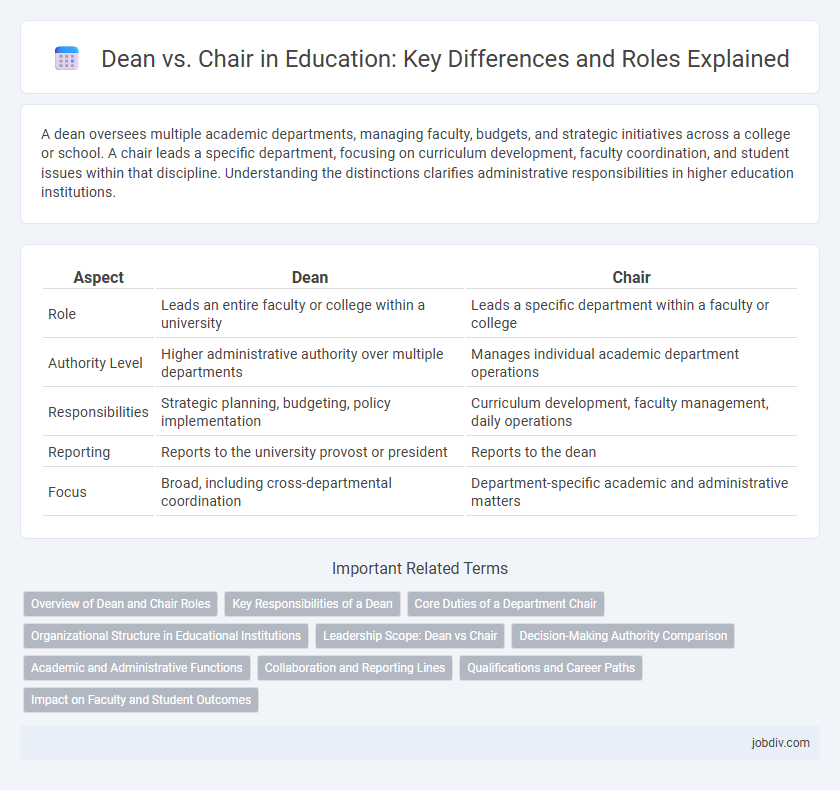A dean oversees multiple academic departments, managing faculty, budgets, and strategic initiatives across a college or school. A chair leads a specific department, focusing on curriculum development, faculty coordination, and student issues within that discipline. Understanding the distinctions clarifies administrative responsibilities in higher education institutions.
Table of Comparison
| Aspect | Dean | Chair |
|---|---|---|
| Role | Leads an entire faculty or college within a university | Leads a specific department within a faculty or college |
| Authority Level | Higher administrative authority over multiple departments | Manages individual academic department operations |
| Responsibilities | Strategic planning, budgeting, policy implementation | Curriculum development, faculty management, daily operations |
| Reporting | Reports to the university provost or president | Reports to the dean |
| Focus | Broad, including cross-departmental coordination | Department-specific academic and administrative matters |
Overview of Dean and Chair Roles
Deans oversee entire academic units such as colleges or faculties, managing strategic planning, budgeting, and faculty development to ensure institutional goals are met. Chairs lead specific departments, focusing on curriculum management, faculty coordination, and student affairs within their discipline. Both roles require leadership and administrative skills, but deans operate at a higher organizational level with broader responsibilities.
Key Responsibilities of a Dean
Deans oversee the academic, administrative, and financial functions of entire colleges or faculties within a university, ensuring curriculum development aligns with institutional goals. They manage faculty recruitment, budgeting, and strategic planning to foster academic excellence and research innovation. Deans also serve as key liaisons between university leadership, faculty members, and external stakeholders to enhance educational quality and resource allocation.
Core Duties of a Department Chair
A Department Chair primarily oversees the academic and administrative functions of a specific department, including curriculum development, faculty evaluation, and budget management. They facilitate communication between faculty members and higher administration, ensuring departmental goals align with institutional policies. Unlike a Dean who manages multiple departments or faculties, the Chair focuses on the operational and academic leadership within their assigned department.
Organizational Structure in Educational Institutions
In educational institutions, the dean oversees the entire faculty or school, managing academic programs, faculty appointments, and budgeting within a broad organizational structure. The chair, by contrast, leads a specific department or discipline, focusing on curriculum development, faculty coordination, and departmental administration. This hierarchical distinction defines roles and responsibilities, ensuring effective governance and specialized academic leadership.
Leadership Scope: Dean vs Chair
The leadership scope of a Dean encompasses the entire academic division or faculty, overseeing multiple departments, budgeting, strategic planning, and representing the faculty at the university level. In contrast, a Chair leads a single department, focusing on faculty management, curriculum development, and departmental operations. Deans hold broader authority and influence, while Chairs have more specialized leadership within their discipline.
Decision-Making Authority Comparison
The dean holds broader decision-making authority within an academic institution, overseeing multiple departments and setting strategic priorities for faculties or schools. The chair focuses on departmental-level decisions, managing faculty operations, curriculum development, and resource allocation within their specific department. The dean's role involves higher-level policy implementation and cross-departmental coordination, while the chair executes decisions that align with the dean's directives.
Academic and Administrative Functions
The Dean oversees the academic vision and strategic direction of a college or faculty, managing faculty appointments, budgeting, and external relations. The Chair is responsible for the daily administration of a specific department, including curriculum development, faculty performance evaluation, and student affairs within that discipline. While the Dean handles broader institutional leadership, the Chair focuses on department-level academic and administrative operations.
Collaboration and Reporting Lines
Deans oversee multiple departments and coordinate strategic collaboration across faculties, while Chairs manage individual departments, facilitating direct communication between faculty members and administration. Collaboration under a Dean typically involves cross-departmental initiatives, whereas Chairs focus on aligning departmental goals with university policies. Reporting lines place Chairs accountable to Deans, who in turn report to higher university leadership, ensuring structured oversight and integrated academic management.
Qualifications and Career Paths
Deans typically require a doctoral degree in their academic field and extensive experience in higher education administration, often progressing from faculty roles to department chair positions before advancing to dean. Chairs usually hold a master's or doctoral degree and have significant teaching and research experience within their department, serving as a liaison between faculty and administration. Career paths diverge as chairs focus on departmental leadership and faculty management, while deans oversee broader college or school-wide strategic planning and resource allocation.
Impact on Faculty and Student Outcomes
Deans hold broader administrative authority over multiple departments, influencing faculty recruitment, funding allocation, and academic policies that directly shape student curricula and research opportunities. Chairs, with more focused oversight of specific departments, impact daily faculty mentorship and course delivery, allowing for tailored support that can improve faculty effectiveness and student engagement. The leadership style and decision-making power of both roles significantly affect faculty development and student academic success within higher education institutions.
Dean vs Chair Infographic

 jobdiv.com
jobdiv.com